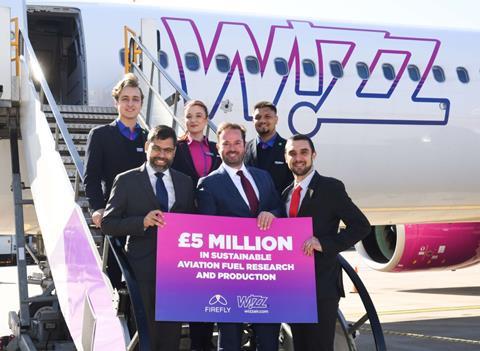European low-cost carrier Wizz Air has struck a long-term deal with UK biofuels firm Firefly Green Fuels to source sustainable aviation fuel (SAF) made from sewage sludge, part of measures it hopes will enable it to achieve its newly set SAF usage targets.
Wizz today set out its goal of powering 10% of its flights with SAF by 2030 and has backed a new pathway being developed by Firefly, which aims to use human waste as a feedstock for the fuel.

The carrier is investing £5 million ($6.3 million) in Firefly to support the development and certification of SAF produced from sewage sludge.
”At Firefly we have chosen to address the decarbonisation of the aviation industry through the perhaps surprising medium of sewage – or to be accurate, through the medium of biosolids,” explained Firefly chief strategy officer Paul Hilditch during a press conference in London today.
”We like biosolids because they are completely biogenic, there is no fossil carbon in this material, which means there is no fossil carbon in the fuel we make from it,” he says. ”We particularly like biosolid [material] because…. it has essentially no intrinsic value, and so we think we are onto a good thing to make large quantities of very sustainable jet fuel at an affordable price.”
He estimates that the there are enough biosolids in the UK to satisfy around half the mandated SAF demand in 2030. “We are not the only answer. But what this shows is this new route to SAF has the potential to move the needle. It has the potential to be significant contributor to the UK SAF supply.”
The investment forms part of what Firefly terms “significant progress” towards commercialisation of its pathway, as part of which it has reached agreement with Haltermann Carless to build a pilot facility at the fuel specialist’s refinery site in Harwich in eastern England. This will be followed by a commercial-scale plant on the same site “shortly thereafter”.
“The testing programme is happening now,” says Hilditch. ”There’s a regulatory process that needs to be gone through. That regulatory process is happening now. Over the next 18 months to two years, that process will continue and then we will have a fully-qualified route to SAF.”
Firefly chief executive James Hygate says production of SAF “in a meaningful volume for use in aviation” is going to be around 2028-2029.
Wizz has signed a 15-year off-take deal for SAF from the plant. ”We are very excited that much of this fuel is going to be going to our partner Wizz Air,” says Hygate. ”We do have a contract with Wizz, a portion of the output of this first facility – over half a million tonnes of SAF over 15 years. That has helped us to get to the point where we are now able to build the facility.”
Wizz Air corporate and ESG officer, Yvonne Moynihan says: ”For us we are hoping that this is a marriage of low-costs. So we have very low-cost feedstocks – it’s perfect to pair that with a low-cost airline.”
The carrier has an aspiration to power 10% of its flights with SAF by 2030.
”SAF is definitely the future as we see it,” says Moynihan. ”That’s why we have taken this step in investing in Firefly. So in addition to investing in our best-technology aircraft, we are looking at partnerships such as Firefly so we can bridge the gap.”


























